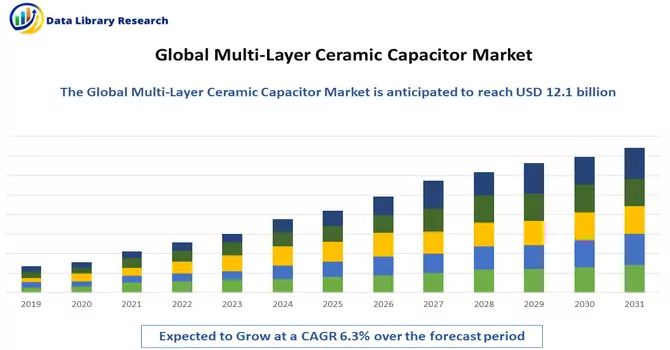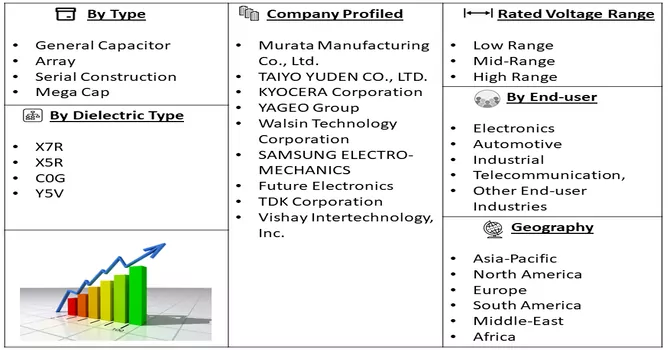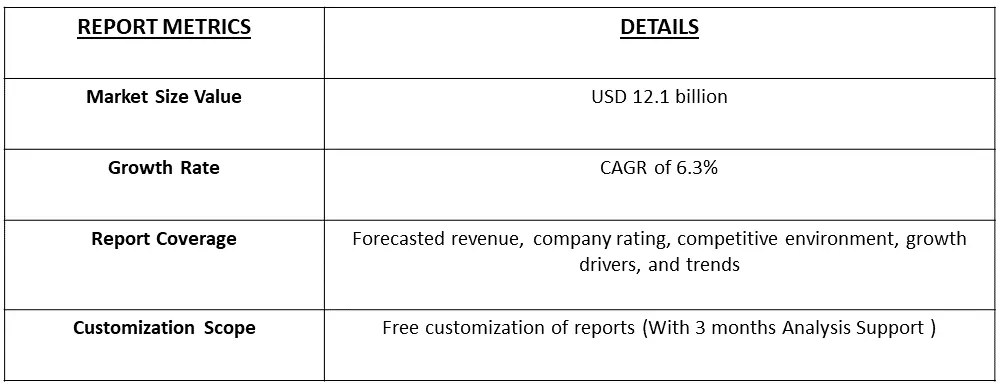The global multi-layer ceramic capacitor market size was valued at USD 12.1 billion in 2023 and is expected to grow at a compound annual growth rate (CAGR) of 6.3% from 2024 to 2031.

Get Complete Analysis Of The Report - Download Free Sample PDF
A Multi-layer Ceramic Capacitor (MLCC) is an electronic component widely used in electronic circuits for energy storage and signal filtering. Comprising multiple layers of ceramic material with alternating conductive layers, MLCCs offer high capacitance values in a compact form. The ceramic layers are typically made of materials like barium titanate, and the conductive layers are composed of a metal, often silver. MLCCs are known for their efficiency in providing capacitance in a small footprint, making them essential components in various electronic devices, including smartphones, computers, and automotive electronics. Their ability to handle high frequencies, stability over a wide temperature range, and relatively low cost contribute to their widespread use in electronic applications, facilitating the smooth and reliable operation of electronic circuits.
Multi-layer ceramic capacitors (MLCCs) are constructed with alternating layers of ceramic and metal, forming a compact and efficient capacitor design. These capacitors exhibit low impedance values, particularly advantageous for noise suppression in electronic devices operating at high frequencies. The escalating need for MLCCs, especially in advanced gadgets like smartphones and tablets, is anticipated to propel market expansion. Furthermore, the increasing demand across diverse sectors such as consumer electronics, data processing, and telecommunications is contributing to the overall growth of the MLCC market. The versatility of MLCCs in addressing the demands of various applications underscores their significance in contemporary electronic devices and highlights their role in sustaining the expanding technology landscape.
Market Segmentation: The Multi-layer Ceramic Capacitor (MLCC) Market is Segmented by Type (General Capacitor, Array, Serial Construction, and Mega Cap), Rated Voltage Range (Low Range, Mid-Range, and High Range), Dielectric Type (X7R, X5R, C0G, and Y5V), End-user Industry (Electronics, Automotive, Industrial, Telecommunication, and Other End-user Industries), and Geography (North America Europe Asia-Pacific Latin America and Middle-East and Africa). The report offers market forecasts and size in volume (billion units) and value (USD) for all the above segments.

For Detailed Market Segmentation - Download Free Sample PDF
Market trends for Multi-layer Ceramic Capacitors (MLCCs) indicate a dynamic landscape shaped by evolving technological demands. MLCCs, composed of alternating ceramic and metal layers, are witnessing increased adoption driven by their low impedance values, particularly advantageous for noise suppression in high-frequency electronic devices. The market is experiencing a surge in demand for MLCCs in cutting-edge gadgets like smartphones and tablets, fueled by the relentless pursuit of miniaturization and enhanced performance. Additionally, MLCCs are becoming integral in various sectors including consumer electronics, data processing, and telecommunications, reflecting a broader application spectrum. The trend towards the Internet of Things (IoT) and 5G technology further underscores the need for compact, high-capacity capacitors, positioning MLCCs at the forefront of innovation in the electronic components sector. The market trends for MLCCs are characterized by their adaptability to emerging technologies and their critical role in supporting the advancements of modern electronic devices across diverse industries.
Market Drivers:
Increasing Demand in Consumer Electronics
One significant market driver for Multilayer Ceramic Capacitors (MLCCs) is the escalating demand in the consumer electronics sector. With the constant evolution of smartphones, tablets, wearables, and other electronic devices, there is a growing need for compact and high-performance capacitors. MLCCs, known for their small size, low impedance, and efficiency at high frequencies, are crucial components in these devices. As consumer electronics continue to advance in terms of functionality and design, the demand for MLCCs is expected to rise, driven by their essential role in ensuring reliable and efficient performance in compact electronic gadgets.
Expansion of IoT and 5G Technologies
The expansion of the Internet of Things (IoT) and the deployment of 5G networks are significant drivers propelling the MLCC market. These emerging technologies demand compact and high-capacity capacitors to meet the requirements of smaller, yet powerful, electronic components. MLCCs, with their ability to provide substantial capacitance in a small form factor, are well-suited for applications in sensors, communication devices, and other IoT-connected devices. The rapid deployment of 5G technology, with its increased data transfer speeds, also necessitates capacitors capable of handling higher frequencies, further fueling the demand for MLCCs in the telecommunications sector.
Market Restraints:
Supply Chain Constraints and Raw Material Availability
One notable market restraint for MLCCs is the potential impact of supply chain constraints and raw material availability. The production of MLCCs relies on specific materials, including ceramics and metals, whose availability and pricing can be influenced by various factors such as geopolitical tensions, trade disputes, and disruptions in the supply chain. Any disruptions in the supply of these essential materials can lead to challenges in manufacturing, potentially causing shortages in MLCC availability. Additionally, fluctuations in raw material costs can affect the overall production cost of MLCCs, influencing pricing dynamics in the market and potentially posing challenges for manufacturers in maintaining a stable supply chain.
The COVID-19 pandemic had a multifaceted impact on the Multilayer Ceramic Capacitor (MLCC) market. Initially, global disruptions, including lockdowns and supply chain interruptions, led to a slowdown in electronic device production, affecting MLCC demand. Economic uncertainties resulted in fluctuations in consumer demand, particularly in sectors like automotive. However, the surge in remote work and digital communication accelerated the need for electronic devices, benefiting the MLCC market. Nevertheless, supply chain disruptions remained a persistent challenge, with shortages affecting the semiconductor industry as a whole. As the industry recalibrates and adapts to the new normal, the MLCC market is expected to rebound, fueled by ongoing technological advancements and the essential role these capacitors play in diverse electronic applications.
Segmental Analysis:
General Capacitor Segment is Expected to Witness Significant Growth Over the Forecast Period
Capacitors are essential electronic components that store and release electrical energy in electrical circuits. A general capacitor consists of two conductive plates separated by an insulating material known as a dielectric. When a voltage is applied across the capacitor, an electric field forms between the plates, causing the accumulation of electric charge. Capacitors are characterized by their capacitance, which is the ability to store charge per unit voltage. They play a crucial role in various electronic applications, serving functions such as energy storage, signal coupling, filtering, and timing. Capacitors come in diverse types, including electrolytic capacitors, ceramic capacitors, tantalum capacitors, and film capacitors, each designed for specific applications based on factors like capacitance values, voltage ratings, and temperature stability. The versatility of capacitors makes them indispensable in electronics, contributing to the efficient operation of electronic devices across industries, from consumer electronics to automotive systems and power distribution networks.
Mid-Range Segment is Expected to Witness Significant Growth Over the Forecast Period
A mid-range multilayer ceramic capacitor (MLCC) refers to a capacitor within a specific capacitance range, typically falling between low and high capacitance values available in the MLCC market. MLCCs are constructed with multiple layers of ceramic material and metal, providing efficient energy storage and signal coupling in electronic circuits. The term "mid-range" indicates that the capacitor's capacitance value falls within a moderate or intermediate range, making it suitable for various applications. These capacitors are often chosen based on factors such as voltage requirements, size constraints, and frequency stability. Their versatility places mid-range MLCCs in a sweet spot, catering to a broad spectrum of electronic devices and applications where a balance between size, performance, and cost is essential. The specific capacitance range considered as mid-range can vary based on industry standards and the evolving demands of electronic technologies.
X7R Segment is Expected to Witness Significant Growth Over the Forecast Period
The X7R segment in the realm of Multilayer Ceramic Capacitors (MLCCs) represents a specific category characterized by the X7R dielectric material. Dielectrics determine the capacitor's electrical properties, and X7R is a type known for its stable capacitance over a wide range of temperatures. MLCCs with X7R dielectric material exhibit a moderate temperature coefficient, making them suitable for applications that require stable capacitance values across varying temperature conditions. These capacitors find extensive use in electronic circuits where temperature stability and reliability are crucial. The X7R MLCCs strike a balance between cost-effectiveness and performance, making them versatile components employed in a variety of applications, including telecommunications, automotive electronics, and power supplies. The X7R segment within the MLCC market reflects the ongoing efforts to meet specific performance requirements across diverse industries while optimizing factors like size, temperature stability, and overall functionality.
Automotive Segment is Expected to Witness Significant Growth Over the Forecast Period
Automotive applications have become a significant and rapidly growing sector for Multilayer Ceramic Capacitors (MLCCs). MLCCs play a crucial role in various electronic systems within vehicles, offering compact and reliable solutions for energy storage, signal coupling, filtering, and voltage regulation. As modern automobiles continue to integrate advanced technologies such as advanced driver assistance systems (ADAS), infotainment systems, and electric drivetrains, the demand for MLCCs has surged. These capacitors contribute to the efficiency and functionality of engine control units, sensors, power modules, and communication modules, enhancing the overall performance and safety of vehicles. The automotive industry's shift towards electrification has further intensified the need for high-capacity, compact MLCCs in electric vehicles (EVs) and hybrid electric vehicles (HEVs). However, the automotive sector also poses unique challenges for MLCCs, such as stringent reliability standards, exposure to harsh operating conditions, and the requirement for extended temperature ranges. Manufacturers are responding by developing automotive-grade MLCCs that meet the industry's strict quality and reliability standards, ensuring robust performance in challenging automotive environments. The symbiotic relationship between automotive technology advancements and MLCC innovation underscores the critical role these capacitors play in shaping the future of automotive electronics.
North America Region is Expected to Witness Significant Growth Over the Forecast Period
North America stands as a pivotal market for Multilayer Ceramic Capacitors (MLCCs), playing a significant role in the global electronics industry. MLCCs are integral components used in a wide range of electronic devices, and their demand in North America is fueled by the region's thriving automotive, telecommunications, consumer electronics, and industrial sectors. The United States and Canada, in particular, house key industries that heavily rely on MLCCs for their electronic applications. The automotive sector in North America, including the development of electric vehicles (EVs) and advanced driver assistance systems (ADAS), contributes to the increasing demand for MLCCs in the region. Telecommunications infrastructure expansion and the continuous evolution of consumer electronics also drive the demand for high-performance MLCCs. As the push for 5G technology and the Internet of Things (IoT) advances, the need for reliable and compact MLCCs in North America is expected to grow further. Additionally, manufacturers in the region focus on developing MLCCs that meet stringent industry standards, ensuring reliability and performance in diverse applications. The North American MLCC market reflects the region's commitment to technological innovation and its pivotal role in shaping the global electronics landscape.

Get Complete Analysis Of The Report - Download Free Sample PDF
The international market is experiencing substantial expansion on a global scale, propelled by various factors including heightened demand in the automotive industry, a necessity for smaller and more compact electronic devices, the widespread adoption of advanced technologies such as 5G and IoT, and an overarching emphasis on environmental sustainability and energy efficiency. Key industry players are strategically employing both organic and inorganic growth strategies to uphold and strengthen their positions within the market. This includes not only fostering internal growth but also engaging in mergers, acquisitions, and other collaborative efforts to navigate the evolving landscape and maintain a competitive edge in the industry. Key Multi-layer Ceramic Capacitor Companies:
Recent Development:
1) In May 2023, Murata Manufacturing Co. Ltd unveiled its latest advancement in multi-layer ceramic capacitors (MLCCs), aiming to meet the rising demand for components featuring increased capacitance levels within compact form factors and improved temperature performance. This innovation, part of the GRM series, offers capacitance values of 10µF with a ±20% tolerance and is packaged in the 0201inch/0603M size, currently standing as the smallest MLCC product on the market capable of delivering such capacitance levels. This marks a substantial 65% reduction in size compared to the 0402-inch/1005M products typically specified for similar requirements.
2) In April 2023, Samsung Electro-Mechanics introduced an MLCC product in the 1210-inch size with a capacitance of 220 μF, specifically designed for automotive applications. This product is intended for use in advanced driver assistance systems (ADAS) and autonomous driving (AD), catering to the increasing need for MLCCs in the rapidly growing automotive electrification sector, emphasizing the expanding role of MLCCs in various functions within vehicles.
Q1. What was the Multi-Layer Ceramic Capacitor Market size in 2023?
The Multi-Layer Ceramic Capacitor Market size was valued at USD 12.1 billion in 2023.
Q2. At what CAGR is the Multi-Layer Ceramic Capacitor market projected to grow within the forecast period?
Multi-Layer Ceramic Capacitor market is expected to grow at a compound annual growth rate (CAGR) of 6.3% Over the forecast period.
Q3. What are the factors driving the Multi-Layer Ceramic Capacitor market?
Key factors that are driving the growth include the Increasing Demand in Consumer Electronics and Expansion of IoT and 5G Technologies.
Q4. Which region has the largest share of the Multi-Layer Ceramic Capacitor market? What are the largest region's market size and growth rate?
North America has the largest share of the market. For detailed insights on the largest region's market size and growth rate request a sample here.
Data Library Research are conducted by industry experts who offer insight on industry structure, market segmentations technology assessment and competitive landscape (CL), and penetration, as well as on emerging trends. Their analysis is based on primary interviews (~ 80%) and secondary research (~ 20%) as well as years of professional expertise in their respective industries. Adding to this, by analysing historical trends and current market positions, our analysts predict where the market will be headed for the next five years. Furthermore, the varying trends of segment & categories geographically presented are also studied and the estimated based on the primary & secondary research.
In this particular report from the supply side Data Library Research has conducted primary surveys (interviews) with the key level executives (VP, CEO’s, Marketing Director, Business Development Manager and SOFT) of the companies that active & prominent as well as the midsized organization
FIGURE 1: DLR RESEARH PROCESS

Extensive primary research was conducted to gain a deeper insight of the market and industry performance. The analysis is based on both primary and secondary research as well as years of professional expertise in the respective industries.
In addition to analysing current and historical trends, our analysts predict where the market is headed over the next five years.
It varies by segment for these categories geographically presented in the list of market tables. Speaking about this particular report we have conducted primary surveys (interviews) with the key level executives (VP, CEO’s, Marketing Director, Business Development Manager and many more) of the major players active in the market.
Secondary ResearchSecondary research was mainly used to collect and identify information useful for the extensive, technical, market-oriented, and Friend’s study of the Global Extra Neutral Alcohol. It was also used to obtain key information about major players, market classification and segmentation according to the industry trends, geographical markets, and developments related to the market and technology perspectives. For this study, analysts have gathered information from various credible sources, such as annual reports, sec filings, journals, white papers, SOFT presentations, and company web sites.
Market Size EstimationBoth, top-down and bottom-up approaches were used to estimate and validate the size of the Global market and to estimate the size of various other dependent submarkets in the overall Extra Neutral Alcohol. The key players in the market were identified through secondary research and their market contributions in the respective geographies were determined through primary and secondary research.
Forecast Model
